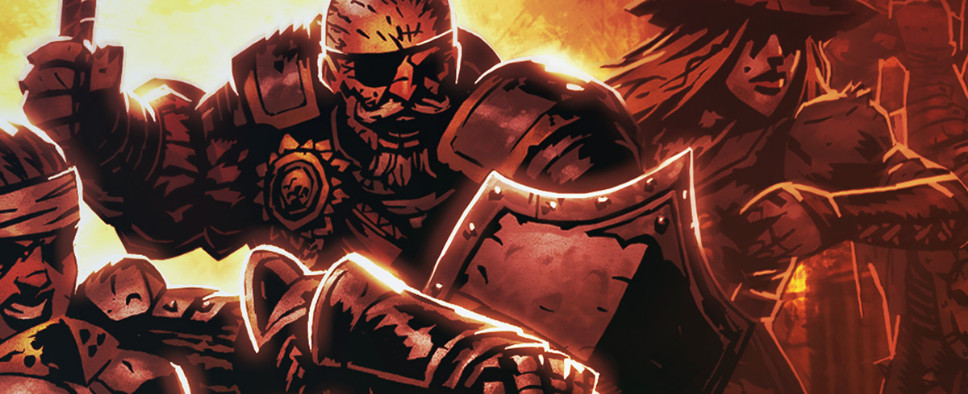Procedural Narratives and Indie Game Writing
-
Category: News ArchiveHits: 2187

This Gamasutra article explores the viability of so-called “procedural narratives” within the context of indie video game writing. The article uses Darkest Dungeon and Path of Exile as examples of games that do procedural narratives right and raises some good points. An excerpt:
I once heard narrative design likened to theme park design. A park ride might have a story context, a must-have for any haunted house or ghost train ride, and the ticket-holder then explores that context, feels part of that miniature world for a bit. It’s a tough thing to explain in abstract so let’s get concrete with one of my favorite ever Indie RPGs. Darkest Dungeon.
Being a rogue-like RPG, Darkest Dungeon is all about the experience of delving into Lovecraftian realms, surviving by the skin of your teeth and going completely bonkers in the process. There is no ‘plot’ beyond the usual fare of ‘mad overreacher explores where he should not and unearths an ancient evil that then corrupts the entire place’. Sounds like a hundred games, stories and novels already, right? And it would’ve been no different to the rest had not the creators stopped right there and said, “Plot, shmot! Let’s give the player a story-rich experience instead.” I’m sure that wasn’t their exact words, but the spirit of that statement permeates almost every element of Darkest Dungeon.
Darkest Dungeon wrangles its world design, glyphs and dialogue in such a way as to totally wrap the player in story without ever demanding that they follow any sort of plot. As soon as a player follows a plot then their choices are limited. Darkest Dungeon’s limits are mechanical, not narrative. You can pretty much engage with whichever elements you want, whenever you want, within the confines of what’s possible for you at the time. I’m going to go into the specific elements in more depth later on. For now, let’s dip our tootsies in this narrative bloodbath so we can get an overall feel for what Darkest Dungeon does.
Your progress in Darkest Dungeon is defined by character levels, character health (both physical and mental) and how much of the game’s hometown, The Hamlet, you’ve managed to rebuild and upgrade. In fact, the hamlet itself is as much an RPG character as the adventurers that use it as their base of operations.
For a start, the adventurers themselves are the sort of troubled types you’d find in any Lovecraftian horror.
Houndmaster - “A lawman and his faithful beast. A bond forged by battle and bloodshed.”
Leper - “This man understands that adversity and existence are one and the same.”
Antiquarian - “She searches where others will not go...and sees what others will not see.”
That’s all the backstory you get, and that’s all the backstory you need in a game like Darkest Dungeon. Each adventurer is a lump of clay for the player to mould. Different varieties of clay, yes, with different properties, but with plenty of scope for the player to stamp them with personality and sculpt them with experience.
And where does all of this personality and experience come from? Well, mostly from the horrors the adventurers have to deal with in those antediluvian depths. Frightening monstrosities, eldritch curses, itchy and icky illnesses, and the ever-pervading gloom itself.
Darkest Dungeon needs no character arcs nor ticking plot devices. It has game mechanics! Each adventurer has a Stress counter. When that stress counter rises too high, the adventurer in question ‘cracks’ and develops some rather peculiar psychological maladies. Selfishness, masochism, hopelessness, irrationality and paranoia...this list of afflictions go on. And the result? The adventurers actually start to behave differently during combat. A ‘masochist’ will race to the front of the party of their own volition so they can invite the most damage upon themselves. An adventurer who is feeling ‘hopeless’ may decide to skip their combat turn. A ‘fearful’ adventurer will shift themselves to the back of the pack whilst ranting in such a terrified manner that it raises everyone else’s stress counts. An ‘abusive’ adventurer will cast aspersions on his party-mates, resulting in ever further increased stress counts.
In a nutshell, or nutcase in this instance, each character’s story context is expressed through mechanics and succinct text bubbles. No expensive voice over (apart from that wonderfully creepy narrator), no plot to adhere too, and yet the group dynamics are as clear and complex an expression as one might find in a soap opera.

